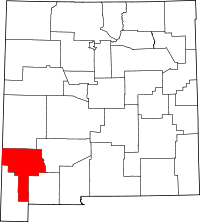Santa Rita, New Mexico
Coordinates: 32°48′13″N 108°03′39″W / 32.80361°N 108.06083°W

Santa Rita is a ghost town in Grant County in the U.S. state of New Mexico. The site of Chino copper mine, Santa Rita was located fifteen miles east of Silver City.
History
Copper mining in the area began late in the Spanish colonial period, but it was not until 1803 that Franscisco Manuel Elguea, a Chihuahua banker and businessman, founded the town of Santa Rita. He named it Santa Rita del Cobre (Saint Rita of the Copper), after Saint Rita of Cascia and the existing mine. During the early 19th century the mine produced over 6 million pounds of copper annually.[1] The crudely smeltered ore was shipped to Chihuahua for further smelting and then sent to Mexico City on mule back.[1] The area was relatively peaceful, despite an occasional attack from the Warm Springs (Mimbres) band of the Chiricahua Apache, who lived nearby at the headwaters of the Gila and Mimbres rivers. In 1837, however, an American trader named John Johnson lured the Apaches to a gathering and then massacred them to sell their scalps for the bounty offer by the Mexican government. [2] This caused open warfare and almost all of the nearly 500 inhabitants of Santa Rita were killed in an attack on the town; only six managed to reach safety in Chihuahua.[3] The town was abandoned until 1849, when the U.S.Army established a command post on the site, calling it Cantonment Dawson.[4] (See Apache-Mexico Wars)
Martin B. Hayes reopened the mine in 1873[5] after Cochise signed a treaty of peace; however, the town continued to be subject to Apache attacks from Geronimo, Victorio and other Apache warleaders until 1886, when Geronimo surrendered for the last time. A post office opened in 1881 and the coming of the railroad five years later spurred further development of the mine.
After the Santa Rita mine was converted to an open pit in 1901, the town was forced to move several times as the pit grew. Shortly after the town relocated in 1957, heavy rains washed boulders and mud into the new townsite.[6] The town was abandoned once and for all in 1967, and the school system for the area was discontinued in 1972.[7]
The population of Santa Rita was about 500 in 1884. By 1915 it was 2500, and by 1920 had reached 6,000.[5] It remained at 6,000 until significant layoffs at the mine started in the 1950s.[5]
Notable residents
- Ralph Kiner, member of the National Baseball Hall of Fame[8]
- Harrison Schmitt, geologist and Apollo 17 astronaut[9]
- William Harrell Nellis, for whom Nellis Air Force Base was named.[10]
References
- Notes
- 1 2 New Mexico Office of Cultural Affairs (1995) "Santa Rite" Enchanted Lifeways: The history, musueums, arts & festivals of New Mexico New Mexico Magazine, Santa Fe, N.M., p. 186, ISBN 0-937206-39-3
- ↑ Strickland, Rex W. "The Birth and Death of a Legend: The Johnson 'Massacre' of 1837" Arizona and the West, Vol 18, No. 3 (Autumn 1976), p. 257-286
- ↑ Sinclair, John L. (2003) "Santa Rita — the town that vanished into thin air" SouthernNewMexico.com
- ↑ Staff (6 August 1970) "History Students Relive Conquest of Frontier" Silver City Daily Press Section Two, p.17
- 1 2 3 Cooper, James E. (1975) "Santa Rita" Ghost Towns and Mining Camps of New Mexico University of Oklahoma Press, Norman, OK, pp. 188-191, ISBN 0-8061-1066-X
- ↑ Staff (9 August 1957) "Flood Waters Hit Mine Pit" The Albuquerque Tribune 35(105): p. 1
- ↑ Walz, Kent (30 August 1972) "Local School Systems Short of Projections" Silver City Daily Press p. 1
- ↑ "Ralph Kiner" National Baseball Hall of Fame
- ↑ "Astronaut Bio: Harrison Schmitt" NASA
- ↑ "Factsheet: Lieutenant William Harrell Nellis", Nellis Air Force Base, retrieved 18 September 2008
- Bibliography
- Julyan, Robert Hixson (1998) "Santa Rita" The place names of New Mexico (2nd ed.) University of New Mexico Press, Albuquerque, NM, p. 326, ISBN 0-8263-1688-3
- Pearce, T. M. (1965) "Santa Rita" New Mexico place names; a geographical dictionary University of New Mexico Press, Albuquerque, NM, p. 149, OCLC 420847
External links
- Sinclair, John L. (2003) "Santa Rita — the town that vanished into thin air" SouthernNewMexico.com
- "Santarita" Ghost Towns and History of the American West
